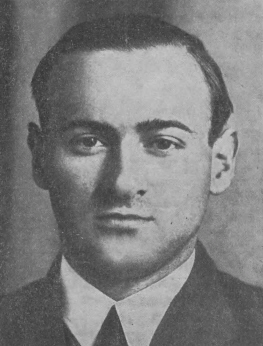
Aron Nimzowitsch was a Latvian-born Danish chess player and writer. In the late 1920s, Nimzowitsch was one of the best chess players in the world. He was the foremost figure amongst the hypermoderns and wrote a very influential book on chess theory: My System (1925–1927). Nimzowitsch's seminal work Chess Praxis, originally published in German in 1929, was purchased by a pre-teen and future World Champion Tigran Petrosian and was to have a great influence on his development as a chess player.

Alexander Aleksandrovich Alekhine was a Russian and French chess player and the fourth World Chess Champion, a title he held for two reigns.

Sanremo or San Remo is a comune (municipality) on the Mediterranean coast of Liguria, in northwestern Italy. Founded in Roman times, it has a population of 55,000, and is known as a tourist destination on the Italian Riviera. It hosts numerous cultural events, such as the Sanremo Music Festival and the Milan–San Remo cycling classic.

Efim Bogoljubow, also known as Efim Dimitrijewitsch Bogoljubow, was a Russian-born German chess grandmaster.

Fred Dewhirst Yates was an English chess master who won the British Chess Championship on six occasions. He started a career in accountancy, but in 1909, abandoned it in favour of becoming a professional chess player and journalist.
The Rubinstein Trap is a chess opening trap in the Queen's Gambit Declined, Orthodox Defense. Black loses a pawn after Nxd5 due to the threat of his queen being trapped on the back rank by White's Bc7.
Alekhine's gun is a formation in chess named after the former world chess champion Alexander Alekhine. It is a specific kind of battery. This formation was named after a game he played against Aron Nimzowitsch in Sanremo 1930, ending with Alekhine's decisive victory.

Friedrich Sämisch was a German chess player and chess theorist. He was among the inaugural recipients of the title International Grandmaster from FIDE in 1950.
Mario Monticelli was an Italian chess player. He was awarded the International Master (IM) title in 1950 and the Grandmaster title honoris causa (GME) in 1985.
José Joaquín Araiza Vázquez was a Mexican chess master.

Hans Fahrni was a Swiss chess master.

Roberto Gabriel Grau was an Argentine chess master. He was born and died in Buenos Aires. In the late 1920s he was Argentina's strongest chess-player.

Carl Oscar Ahues was a German chess International Master.

Stefano Rosselli del Turco, Marquis, was an Italian chess player, writer and publisher. He was five times Italian champion and represented Italy in the Chess Olympiad seven times. He was a member of the famous Rosselli del Turco noble family of Florence.
Massimiliano "Massimo" Romi was an Italian chess master.
The Sanremo Open is a defunct men's tennis tournament that was part of the World Series of the ATP Tour for one year in July/August 1990. The event was held in Sanremo, northern Italy, and was played on outdoor clay courts. It was the successor tournament to the historical San Remo International.
Bled 1931 chess tournament was a major chess tournament proposed by Milan Vidmar and held in 1931 in Bled and Ljubljana, Slovenia, then part of the Kingdom of Yugoslavia.
The Carlsbad 1929 chess tournament was one of four well-known international chess tournaments held in the spa city of Carlsbad. The other tournament years were 1907, 1911 and 1923.
Zurich 1934 was an international chess tournament held in Zurich from 14 to 29 July 1934 to commemorate the 125th anniversary of Schachgesellschaft Zürich. Alexander Alekhine won, followed by Max Euwe and Salo Flohr tied for second-third. The tournament also served as the 1934 Swiss Championship, won by Hans Johner as the highest-ranking Swiss player.










